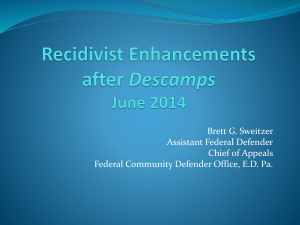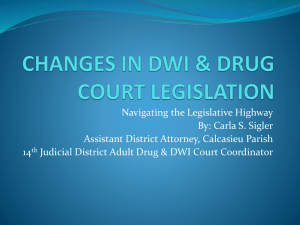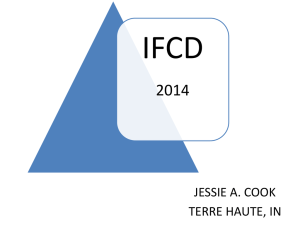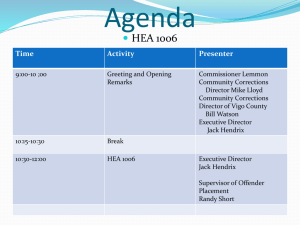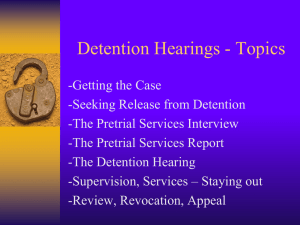Armed Career Criminal Enhancement
advertisement
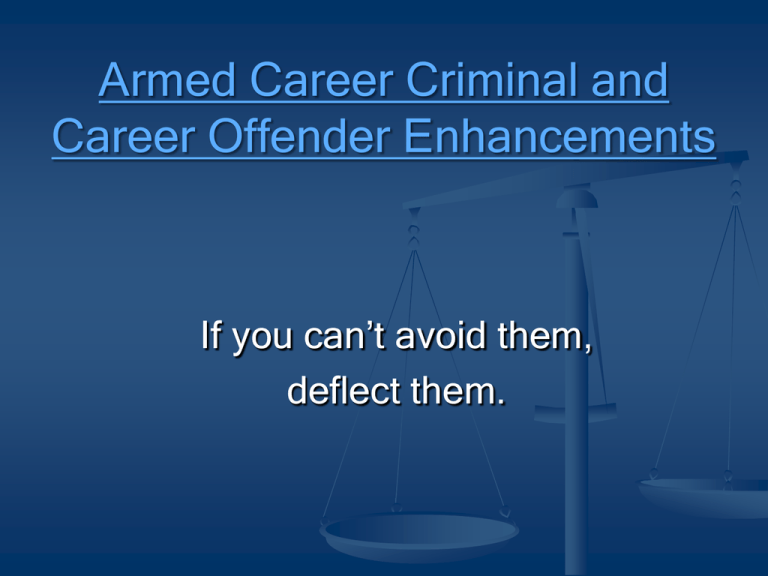
Armed Career Criminal and Career Offender Enhancements If you can’t avoid them, deflect them. ACCA - mandatory 15 year sentence: Who does it apply to? Defendant must: be adjudicated guilty under 18 U.S.C. § 922(g) (guns and ammunition); have three prior convictions (committed at different times) for either (or combination): “violent felony” “serious drug offense” Career Offender Guideline: Who does it apply to? Defendant must be 18 at time he commits the instant offense; The instant offense is a felony “crime of violence” or a “controlled substance offense”; The defendant has at least two prior felony convictions which are either a “crime of violence” or a “controlled substance offense” (or a combination). In-depth analysis of ACCA What counts as prior convictions? Age of prior conviction is irrelevant. The prior convictions must have been adjudicated before Defendant committed the present offense. Cases consolidated for purposes of sentencing that were committed on different occasions are treated as separate under ACCA. See United States v. Hudspeth, 42 F.3d 1015, 1021 (7th Cir. 1994)(commission of 3 different burglaries against 3 different victims over the course of 30 minutes). What counts as prior convictions? Conspiracy, Aiding and Abetting, and Attempts to commit “violent felony” or “serious drug offense” may qualify. Circuit split as to whether juvenile convictions qualify. Validity of prior conviction cannot be challenged except where prior was based on the complete denial of the right to counsel. Custis v. United States, 511 U.S. 485 (1994). 18 U.S.C. § 924(e)(2)(B) defines “violent felony” as: any felony...that (i) has as an element the use, attempted use, or threatened use of physical force against the person of another; or (ii) is burglary, arson, extortion, involves the use of explosives, or otherwise involves conduct that presents a serious potential risk of physical injury to another. 18 U.S.C. § 924(e)(2)(A) defines “serious drug offense” as: (i) an offense under the Controlled Substance Act (21 U.S.C. § 801 et seq.), the Controlled Substances Import and Export Act (21 U.S.C. § 951 et seq.), or Title 46 Chapter 705, with a maximum term of imprisonment of ten years or more; or (ii) an offense under state law, involving manufacturing, distributing, or possessing with intent to manufacture or distribute with a maximum term of imprisonment of ten years or more. ACCA and Guidelines Statute provides for a minimum of fifteen years. Offense level will be the greatest of: Offense level applicable from Chapters Two and Three; or Offense level from § 4B1.1 (Career Offender), if applicable; or 34, if D used/possessed firearm or ammunition in connection with a crime of violence, controlled substance offense, or if the firearm was one described in 26 U.S.C. § 5845(a); or Level 33 otherwise. ACCA and Guidelines Criminal history is the greatest of: Criminal history under Chapter Four; § 4B1.1 (Career Offender), if applicable; Category VI, if D used/possessed firearm in connection with crime of violence, controlled substance offense, or firearm was one described in 26 U.S.C. § 5845(a); or category IV otherwise. 15 Year mandatory minimum In-depth analysis of Career Offender What counts as prior convictions? Cases consolidated for purposes of sentencing may be treated as separate conviction under Career Offender. Aiding and abetting, conspiracy and attempts to commit “crimes of violence” or “controlled substance offenses” count. See U.S.S.G. § 4B1.2. The provisions of § 4A1.2 apply (some offenses may be too old to count for purposes of career offender or may not apply for other reasons). USSG §4B1.2 defines “crime of violence” as: …any [felony] that: (1) has as an element the use, attempted use, or threatened use of physical force against the person of another; or is burglary of a dwelling, arson, or extortion, involves use of explosives, or otherwise involves conduct that presents a serious potential risk of physical injury to another. USSG §4B1.2 defines “controlled substance offense” as: … a [felony] that prohibits the manufacture, import, export, distribution, or dispensing of a controlled substance (or a counterfeit substance) or the possession of a controlled substance (or a counterfeit substance) with intent to manufacture, import, export, distribute, or dispense. Career Offender Guideline: How it impacts the sentence No statutory mandatory minimum but... The offense level is determined according to the instant offense’s statutory maximum: Life 37 25 or more 34 20 or more 32 Criminal History category becomes a VI. Major differences between ACCA and Career Offender ACCA Career Offender •Instant offense of conviction must be under 18 U.S.C. § 922(g). • Instant offense of conviction must be “crime of violence” or “controlled substance offense.” •3 prior convictions required • 2 prior convictions required • “Violent felony” definition has a broader definition for “burglary”—need not be “burglary of a dwelling” • “Crime of violence” definition is narrower—requires that the burglary be of a dwelling. Deflect these enhancements by attacking the prior convictions We attack prior convictions by using the Taylor analysis, otherwise known as the categorical approach. Taylor v. United States, 495 U.S. 575, 599 (1990). What is the categorical approach / Taylor analysis? A system used by courts to determine whether the statute of conviction fits the definition in question – in the case of ACCA: whether the conviction is a “violent felony” or “serious drug offense” ; in the case of Career Offender: whether a prior conviction is a “crime of violence” or a “controlled substance offense.” Brief overview of Taylor v. United States Mr. Taylor pleads to 922(g). His priors: robbery, assault, and 2 second degree burglary convictions (1963 and 1971). Missouri had several different statutes for second degree burglaries—some including very broad conduct (such as entry into a booth). No documentation showing which particular second degree burglary statute Taylor was convicted under. Eight Circuit affirmed the district court and held that “burglary” under 18 U.S.C. § 924(e)’s definition meant “burglary” however a state chose to define it. Issue before the Court: whether the Missouri second degree burglaries were “violent felonies” under ACCA. Statutes across the country varied as to the type of structure involved and the means of entry. No single meaning for what constituted “burglary.” Court did not want state definition to control: “that would mean that a person convicted of unlawful possession of a firearm, would or would not, receive a sentencing enhancement based on exactly the same conduct, depending on whether the State of his prior conviction happened to call that conduct “burglary.” Taylor, 495 U.S. 575, 579 (1990). The Court identified a “generic” definition for burglary that included elements found in the criminal codes of most states. Burglary : unlawful or unprivileged entry into, or remaining in, a building or structure, with intent to commit a crime. To see if Taylor’s convictions qualified as a “burglary” the Court comes up with the categorical approach. Two step approach to categorical approach / Taylor analysis Step 1: categorical approach Step 2: modified categorical approach Step 1: Categorical approach Determine if the statute of conviction is overbroad: Does the statute of conviction include conduct that may not be covered by the definition in question? If a state statute punishes both conduct that is and is not included in the definition in question then the state statute is overbroad. To determine if the statute of conviction is overbroad, courts only look at the fact of conviction; and the statutory definition of the offense (elements of the offense) not at the underlying facts. Taylor’s two second degree burglary convictions were in 1963 and 1971. In those years, Missouri had different statutes for “second degree burglary” : Breaking and entering a dwelling house (Mo. Rev. Stat § 560.045) Having entered a dwelling house, breaking out of it (Mo. Rev. Stat § 560.050, 560.060) Breaking an inner door (Mo. Rev. Stat § 560.070) Breaking and entering a building, booth, tent, boat or railroad car (Mo. Rev. Stat § 560.075) Breaking and entering a bank (Mo. Rev. Stat § 560.080) Do Missouri’s 2nd degree burglary statutes include both conduct that falls within the definition of violent felony and conduct which does not? Mo. Rev. Stat § 560.075 Breaking and entering Any building…, or any booth or tent, or any boat or vessel, or railroad car… with the intent to steal or commit any crime therein, shall, on conviction, be adjudged guilty of burglary in the second Degree 1) 2) Is it burglary? Are the elements the following: Unlawful or unprivileged entry into, or remaining in, a building or structure, with intent to commit a crime. Does it “otherwise involve conduct that presents a serious potential risk of physical injury to another?” The court did not know which of those statutes Taylor had been convicted under…was he convicted under a statute that fit the generic definition of burglary or was he convicted of a statute that included conduct that fell outside of it? Based on the several statutes and the lack of documentation showing which statute Taylor was convicted under, how is the court to determine whether Taylor’s convictions: fit the definition of “burglary”, or involved “conduct that presents a serious potential risk of physical injury to another”? Since Missouri’s second degree burglary statutes may or may not fit the definition in question—some are overbroad—the modified categorical approach is necessary. Step 2: Modified categorical approach Unlike Step 1, courts look at certain permissible documents to establish whether the conviction in question fits the definition at issue. Government’s burden to prove that the defendant actually violated the statute in a way that fits the definition of violent felony. Courts can only look at “judicially noticeable documents” to determine if underlying conviction is a violent felony. Shepard v. United States, 544 U.S. 13 (2005). Judicially noticeable documents: If conviction obtained through jury trial: charging document and jury instructions. Taylor v. United States, 495 U.S. 575, 599 (1990). If bench trial: judge’s fact. formal rulings of law and findings of Shephard v. United States, 544 U.S. 13, 19 (2005). If case was resolved by way of plea agreement: Charging document (not alone). United States v. Skyes, 598 F.3d 334, 339 (7th Cir. 2010). Signed plea agreement. United States v. Taylor, 630 F.3d 629, 633 (7th Cir. 2010). Transcript of plea colloquy. United States v. Fife, 624 F.3d 441, 445 (7th Cir. 2010). Judgment of conviction. Mata-Guerrero v. Holder, 627 F.3d 256, 260 (7th Cir. 2010). What cannot be included for purposes of the modified categorical approach: police reports PSR Witness statements Rap sheets In Taylor’s case, the Court did not have any judicially noticeable documents that would show that Taylor was convicted under a qualifying statute, so case was vacated and remanded. Practice Tips In conducting a Taylor analysis, it is critical to evaluate the statute of conviction as it existed at the time of the defendant’s prior offense. Do not just look at the current version of the statute as it might have been amended. Order records. Taylor/ categorical approach can be used in many other settings: e.g., child pornography statutes, felon in possession U.S.S.G., §1326 statutes/ U.S.S.G., § 924(c). Conclusion Remember: 1. Do not go by State’s label for the crime. 2. Do not go by the underlying facts. 3. Look at the particular statute your client got convicted under and the cases interpreting that statute. 4. Read the particular enhancement definition very carefully. Resources for CJA Panelists Training Branch, Office of Defender Services WWW.FD.ORG • • • • • • Resources Training Materials and Videos Select Topics in Criminal Defense Sample Memos and Briefs Supreme Court Advocacy Program National Litigation Support Team • • Call Us! Hotline# 202-502-2900 or 800-788-9908 Training • Where can you go? FD.org • • • • Resources List of Training Events • Fills Up • By Group (CJA, AFD’s, Both) • Financial Aid Available On Line Videos Call Us • 202-502-2900 or 800-788-9908 Other Fd.org Resources • • • • Employment Panel Rep’s Local FD’s Search Function Immigration/Padilla National Immigration Justice Center Contacting NIJC’s Defenders Initiative defenders@heartlandalliance.org Call: 312-660-1610 Thank you!
